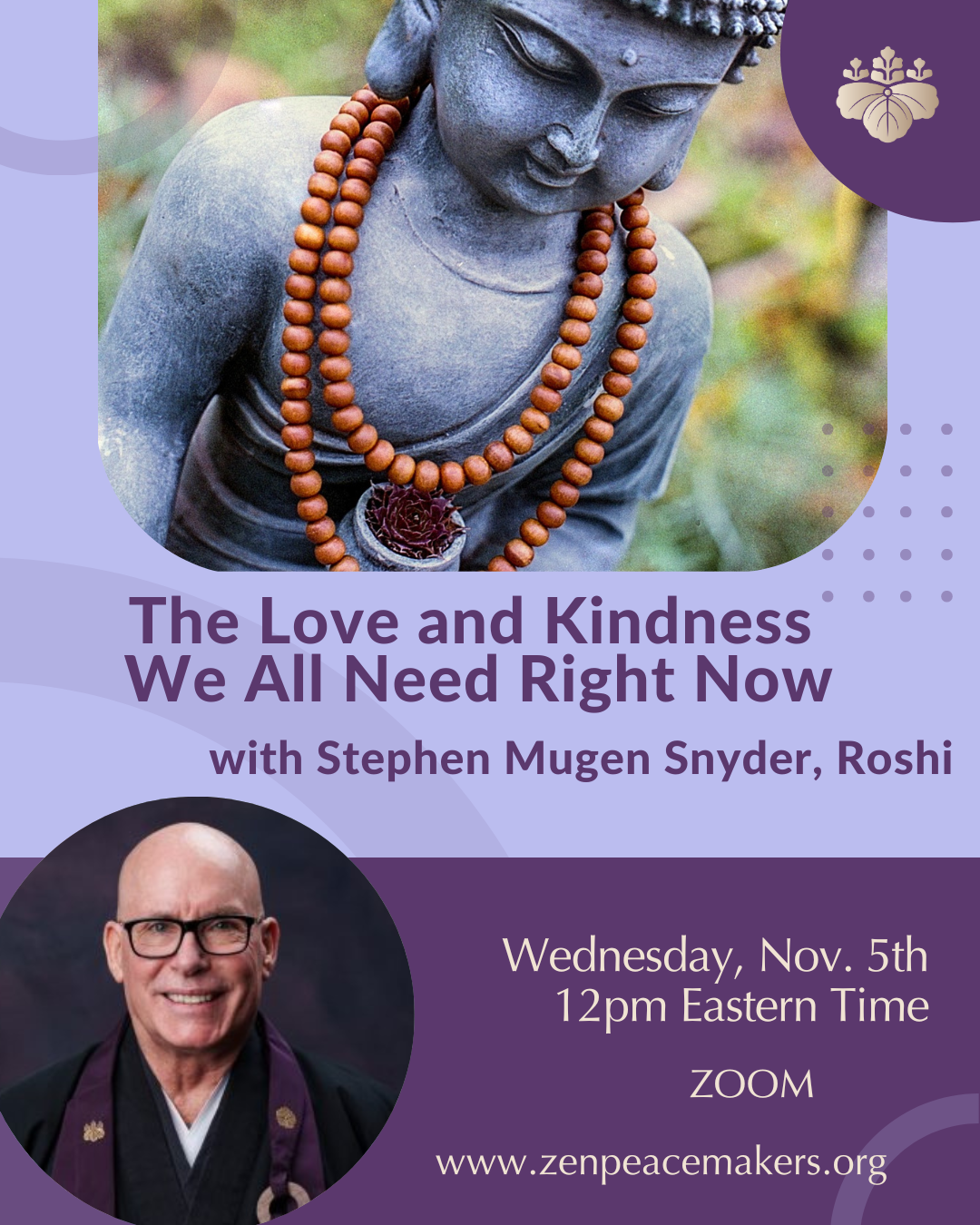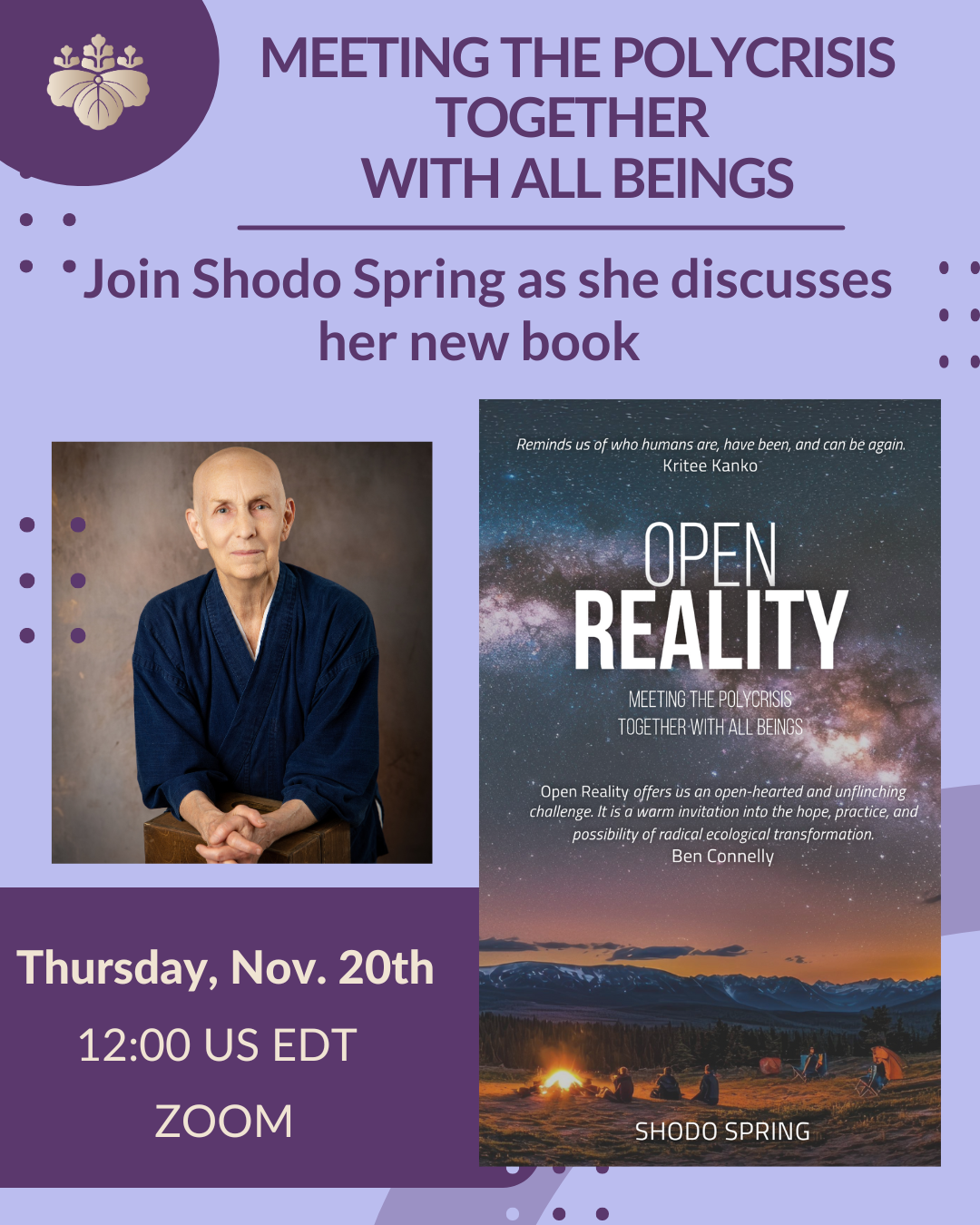Daily Practice
Buddha ancestors have said since ancient times,
“Living for one hundred years does not compare with living for one day and arousing determination for the way.”
Even when you are uncertain, do not use this one day wastefully. It is a rare treasure to value. Do not compare it with an enormous jewel. Do not compare it with a dragon’s bright pearl. Old sages valued this one day more than their own living bodies. Reflect on this quietly. A dragon’s pearl may be found. An enormous jewel may be acquired. But this one day out of a hundred years cannot be retrieved once it is lost. What skillful means can retrieve a day that is passed? No historical documents have recorded such means. Not to waste time is to contain the passage of days and months within your skin bag, without leaking. Thus sages and wise ones in olden times valued each moment, day, and month more than their own eyeballs or the nation’s land. To waste the passage of time is to be confused and stained in the floating world of name and gain. Not to miss the passage of time is to be in alignment with the way.
Once you have clarity, do not neglect a single day. Wholeheartedly practice for the sake of the way and speak for the sake of the way. We know that buddha ancestors of old did not neglect each day’s endeavor. You should reflect on this every day. Sit near a bright window and reflect on this, on mellow and flower-filled days. Sit in a plain building and remember it on a solitary rainy evening. Why does the passage of time steal your endeavor? What kind of enemy is the passage of time? How regrettable to waste your time because of distractions. If you do not know yourself, you will not be able to be your own ally in this great undertaking.
Dogen (1200-1253)
— Excerpted from Enlightenment Unfolds: The Essential Teachings of Zen Master Dogen, by Kazuaki Tanahashi (1999)
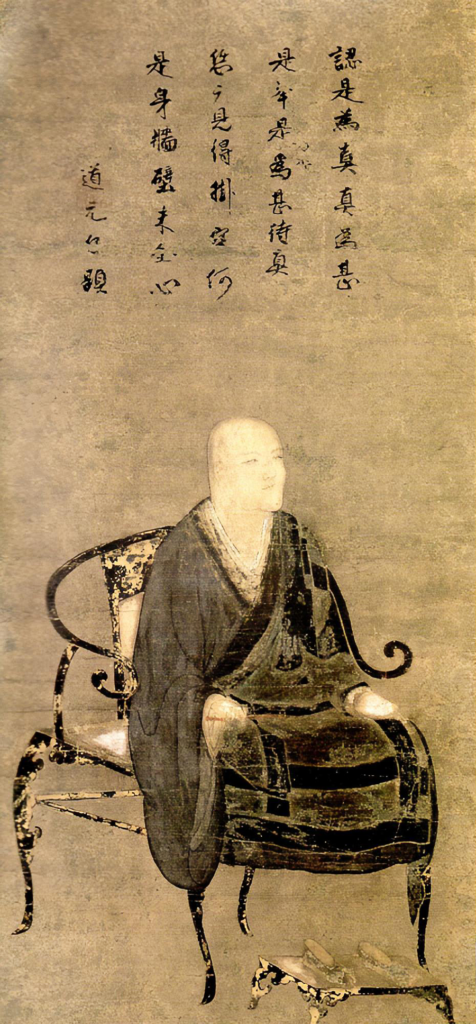
These instructions are reproduced from the Village Zendo‘s website, with permission.
Whatever position you choose, sitting in a chair, full lotus, half-lotus, Burmese, or kneeling with a cushion or bench, choose a posture you can hold comfortably for 30 minutes.
Once seated, roll your hips slightly forward, allowing your belly to relax and your breath to move freely.
Center your spine by gently swaying from left to right in decreasing arcs.
Push the crown of your head toward the ceiling, straightening and extending your spine. Then relax your shoulders.
Your head should not tilt forward or backward or lean to the side. Ears over your shoulders, nose in line with the navel.
Eyes are lowered at a 45-degree angle, looking about three feet in front of you without focusing the gaze. If there is a wall there, look as if you were seeing through the wall.
Lips and teeth should be gently closed, tip of tongue against roof of your mouth behind the front teeth. Swallow and suck the saliva from your mouth, creating a vacuum.
Place your hands in the cosmic mudra, left hand on top of the right, palms up, tips of the thumbs lightly touching, forming a wide oval. Hands should rest on lap, thighs, or lower abdomen, where they do not create a stress on your arms.
The whole point is to find an alert, energetic posture that will allow you to sit very still. Check yourself each time you sit, forming the habit of careful attentiveness to your body posture before zazen.
Breathe in through the nose, letting the air fill your lower abdomen as if it were a balloon, then gently release with a slow, deep out-breath … in and out, in and out.
Count one on the in-breath, two on the out-breath, three on the in-breath, four on the out-breath, and so on, up to ten. Then begin at one again. If it is more comfortable for you, you may count the out-breaths only and follow the in-breath without counting. If a thought causes you to stray from the counting, just notice that, return your focus to the breath, and begin the count again starting at one.
Although written meditation instructions can get you off to a good start, it is helpful to receive personal guidance from an experienced instructor. Above all, enjoy the experience. A great teacher once said that zazen is the gate of peace and compassion.
These instructions are reproduced from the Village Zendo‘s website, with permission.
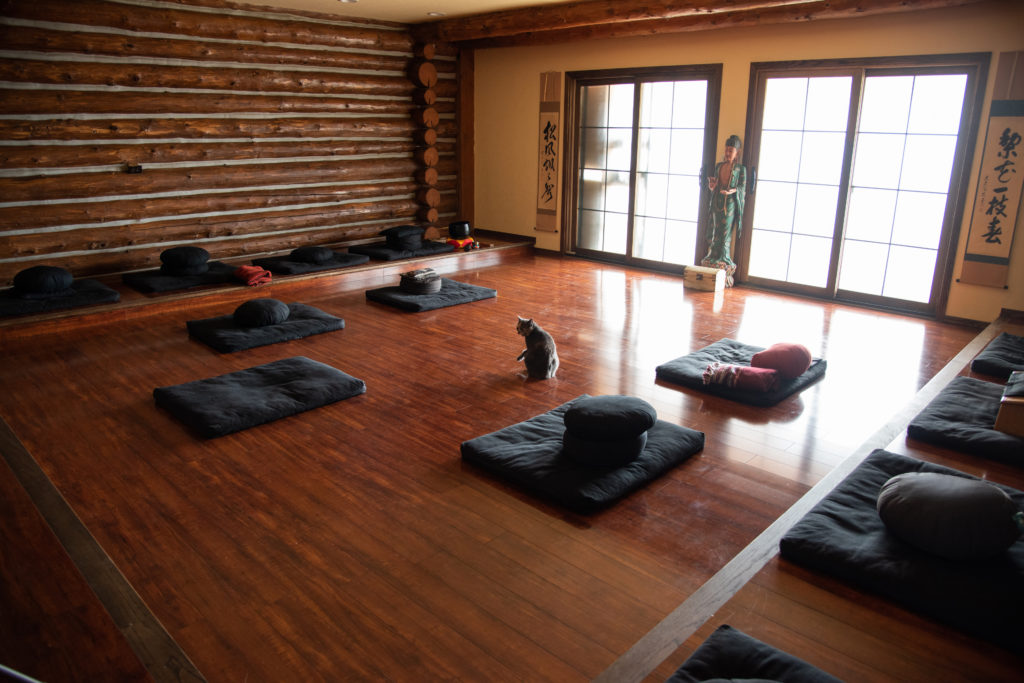
The Way of Council is a core practice of the Zen Peacemakers, along with meditation, the Three Tenets, and social action. It is a staple practice in our Bearing Witness retreats.
Council, as it is referred to in short, is a modern practice derived from indigenous traditions, most importantly Native American, and developed by the Ojai Foundation.
The Circle invites individuals to come together in a dedicated and sacred space, to tune into one’s personal and collective truth, and to the land and nature taking part in the circle. Council is conducted using a set of guidelines, a center altar, and a talking piece which is passed around to indicate a single speaker. With these forms, council enhances our practices of deep listening, bearing witness and empathy. Council focuses our intention and energy on the common stories, values, fears, and aspirations that make us human; it reminds us that we are more alike than we are different. Most importantly, Council is a powerful container to experience the Three Tenets with others, entering the moment of the circle by Not Knowing, Bearing Witness to oneself and others, and Taking Action, relating from the heart.
The intentions of Council are:
1. When listening, listen from the heart, without analyzing, agreeing or disagreeing;
2. When speaking, speak from the heart, naming what is alive right now; Silence is welcome;
3. Be lean of expression, going to the essence of what needs to be spoken;
4. Be spontaneous, trusting what comes, rather than what one has rehearsed or what one thinks should be said;
5. Confidentiality, with deep respect for people’s privacy and the transiency of the moment, participants are encouraged to not engage with other participants on things that came up during council, and not to share its specific content with others.
These guidelines are not rules. They are practices, inviting us to appreciate the immediacy of the moment, the faith in ourselves and others. Each council is opened by an invocation – participants invite that which they would like to be witnessed by, invoke a state of mind, or others. It is closed by a dedication and prayer.
Council has been evoked around the world and during all Zen Peacemakers retreats, street retreats and plunges.
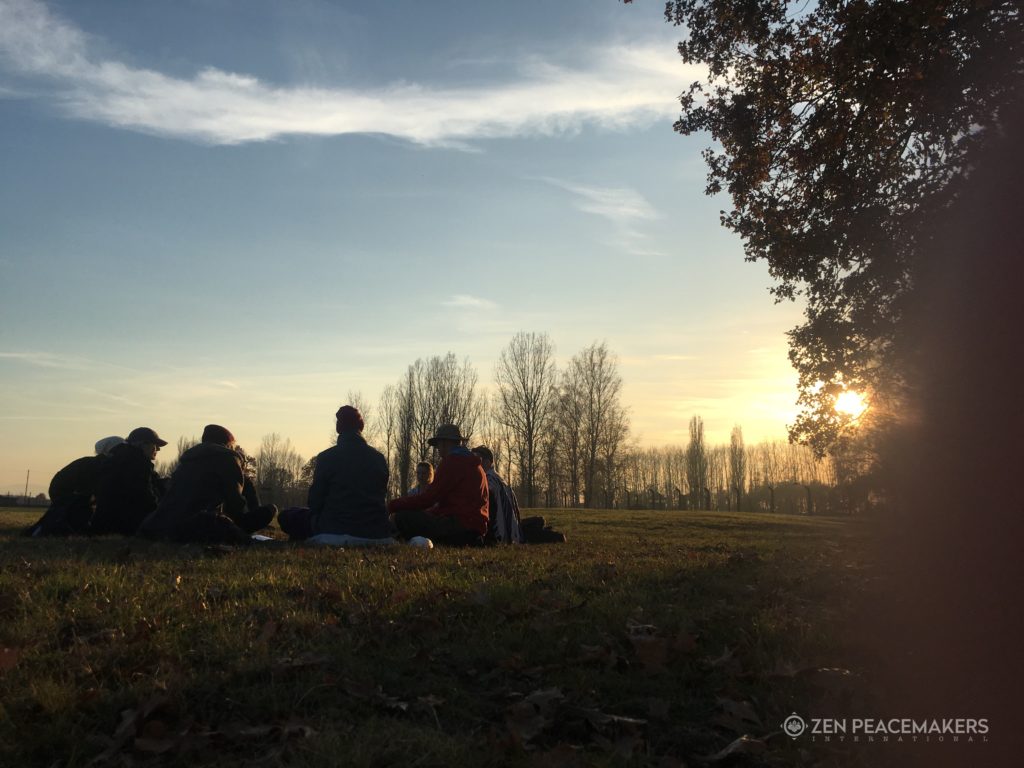
The Three Treasures, The Three Tenets, The Ten Practices, The Four Commitments and The Bodhisattva Vow serve as the foundation for the Zen Peacemaker work and practice. One may pursue their study with a teacher and/preceptor.

Recognizing my place in the Circle of Life, I take refuge in:
- Buddha, the oneness of life
- Dharma, the diversity of life
- Sangha, the interdependence of Buddha and Dharma
Taking refuge in The Three Treasures, I vow to live a life of:
- Not-Knowing, by giving up fixed ideas about ourselves and the universe
- Bearing Witness to the joy and suffering of the world
- Taking Action that arises from Not-Knowing and Bearing Witness
Embodying The Three Tenets, I practice these Precepts:
- Recognizing that I am not separate from all that is. This is the precept of Non-Killing.
- Being satisfied with what I have. This is the precept of Non-Stealing.
- Meeting the diversity of life with respect and dignity. This is the precept of Chaste Conduct.
- Listening and speaking from the heart. This is the precept of Non-Lying.
- Cultivating a mind that sees clearly. This is the precept of Not Being Ignorant.
- Bearing witness to the offering of each moment. This is the precept of Not Talking About Others’ Errors And Faults.
- Speaking what I perceive to be the truth. This is the precept of Not Elevating Myself And Blaming Others.
- Using all the ingredients of my life. This is the precept of Not Being Stingy.
- Bearing witness to emotions that arise. This is the precept of Not Holding On To Anger.
- Honoring my life as a Peacemaker. This is the precept of Not Disparaging The Three Treasures.
Living The Ten Precepts I commit to:
- A reverence for all life;
- A sustainable and ethical economy;
- Equal rights for all;
- Stewardship of the Earth.
Numberless beings, I vow to serve them.
Inexhaustible delusions, I vow to end them.
Boundless Dharmas, I vow to practice them.
Unsurpassable Buddha Way, I vow to embody it.
All karma ever committed by me since of old,
Due to my beginningless greed, hatred, and delusion.
Born of my actions, speech, and thought.
Now I atone for it all.
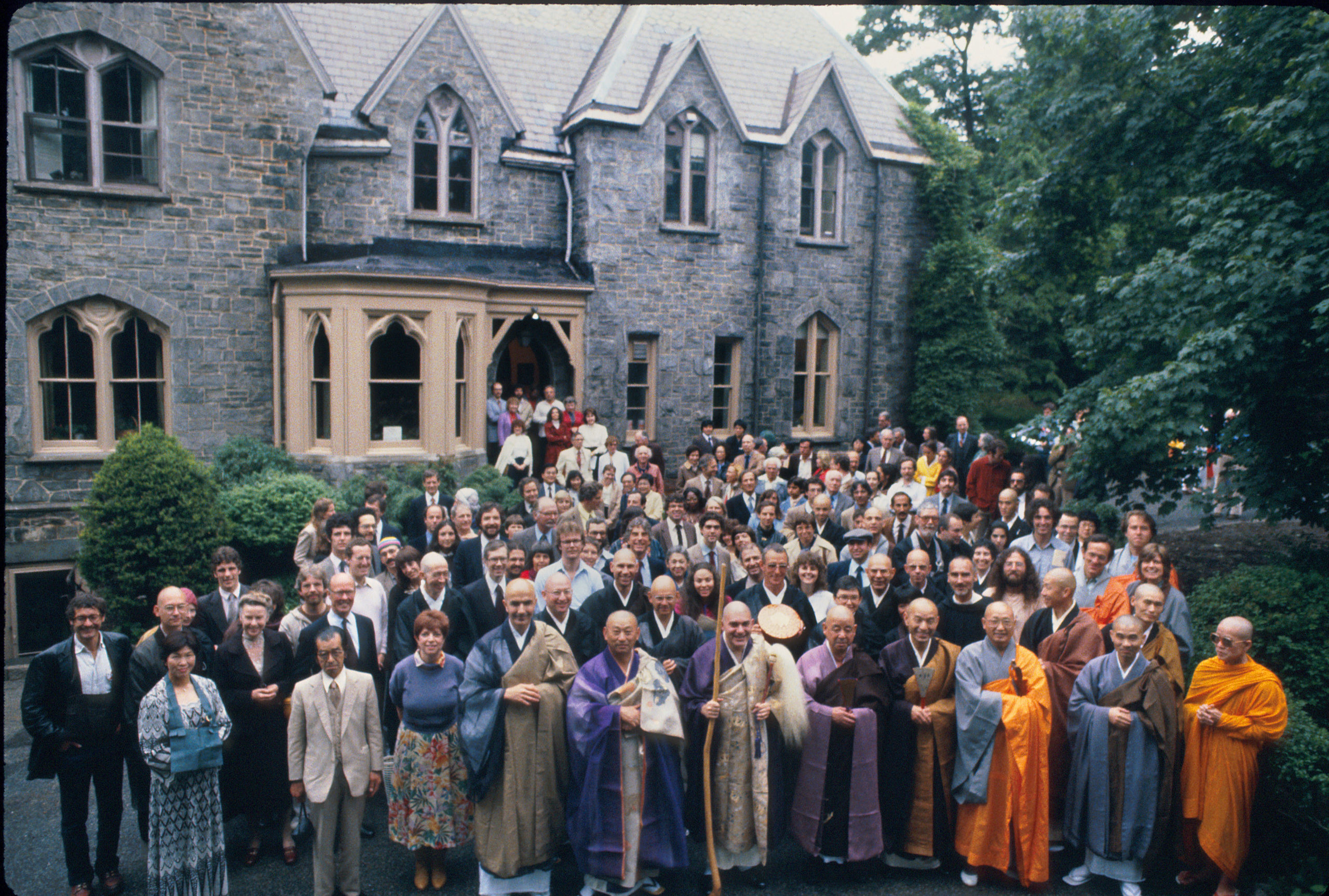
To begin the Day of Reflection, please place your palms together and recite the following with utmost sincerity:
I, _____________, now recite the Gatha of Atonement.
All karma ever committed by me since of old,
Due to my beginningless greed, hatred, and delusion.
Born of my actions, speech, and thought.
Now I atone for it all. (Repeat 3x)
Now being mindful of my actions, speech, and thought, I commit myself to observing this Day of Reflection with the following practices:
I, _____________, take refuge in the Buddha, the oneness of life. I take refuge in the Dharma, the diversity of life. I take refuge in the Sangha, the interdependence of Buddha and Dharma. (Repeat 3x)
I, _____________, for the coming day, commit to Not-knowing by giving up fixed ideas about myself and the universe. I commit to Bearing Witness to the joy and suffering of the universe. I commit to Taking Action that arises from Not-Knowing and Bearing Witness.
As Zen Peacemakers throughout all space and time have practiced the following Ten Precepts, so will I, ______________, observe these practices:
- I will recognize that I am not separate from all that is. This is the practice of Non-killing. I will not lead a harmful life, nor encourage others to do so. I will live in harmony with all life and the environment that sustains it.
- I will be satisfied with what I have. This is the practice of Non-stealing. I will not take anything not given and not encourage others to steal. I will freely give, ask for, and accept what is needed.
- I will meet the diversity of life with respect and dignity. This is the practice of Chaste Conduct. I will not create conditions for others to be unchaste. I will give and accept love and friendship without clinging.
- I will listen and speak from the heart. This is the practice of Non-lying. I will not create conditions for others to lie. I will see and act in accordance with what is.
- I will cultivate a mind that sees clearly. This is the practice of Not Being Deluded. I will not encourage others to be deluded. I will embrace all experience directly.
- I will bear witness to the offering of each moment. This is the practice of Not Talking About Others Errors and Faults. I will not encourage others to talk about others errors and faults. I will acknowledge responsibility for everything in my life.
- I will speak what I perceive to be the truth. This is the practice of Not Elevating Myself and Blaming Others. I will not encourage others to elevate themselves and blame others. I will give my best effort and accept the results.
- I will use all the ingredients of my life. This is the practice of Not Being Stingy. I will not foster a mind of poverty in myself or others.
- I will bear witness to emotions that arise. This is the practice of Not Holding On To Anger. I will not create conditions for others to be angry. I will not harbor resentment, rage, or revenge. I will practice with emotions.
- I will honor my life as a Zen Peacemaker. This is the practice of Not Disparaging The Three Treasures. I will not create conditions for others to disparage The Three Treasures. I will recognize myself and others as manifestations of Buddha, Dharma, and Sangha.
* * *
TRANSFER OF MERIT
To be recited at the end of the Day of Reflection:
I, _____________, have committed myself to this Zen Peacemaker practice of renewing The Three Treasures, The Three Tenets, The Ten Precepts, The Four Commitments and The Bodhisattva Vow for the duration of one day. May the merits of this practice be extended to all those who dedicate their lives to the practice of peace, and to all those who suffer from the oppression of my own greed, hatred, and ignorance. I wish to transform the passions that afflict me, and to realize and actualize the Buddha Way by serving all beings.
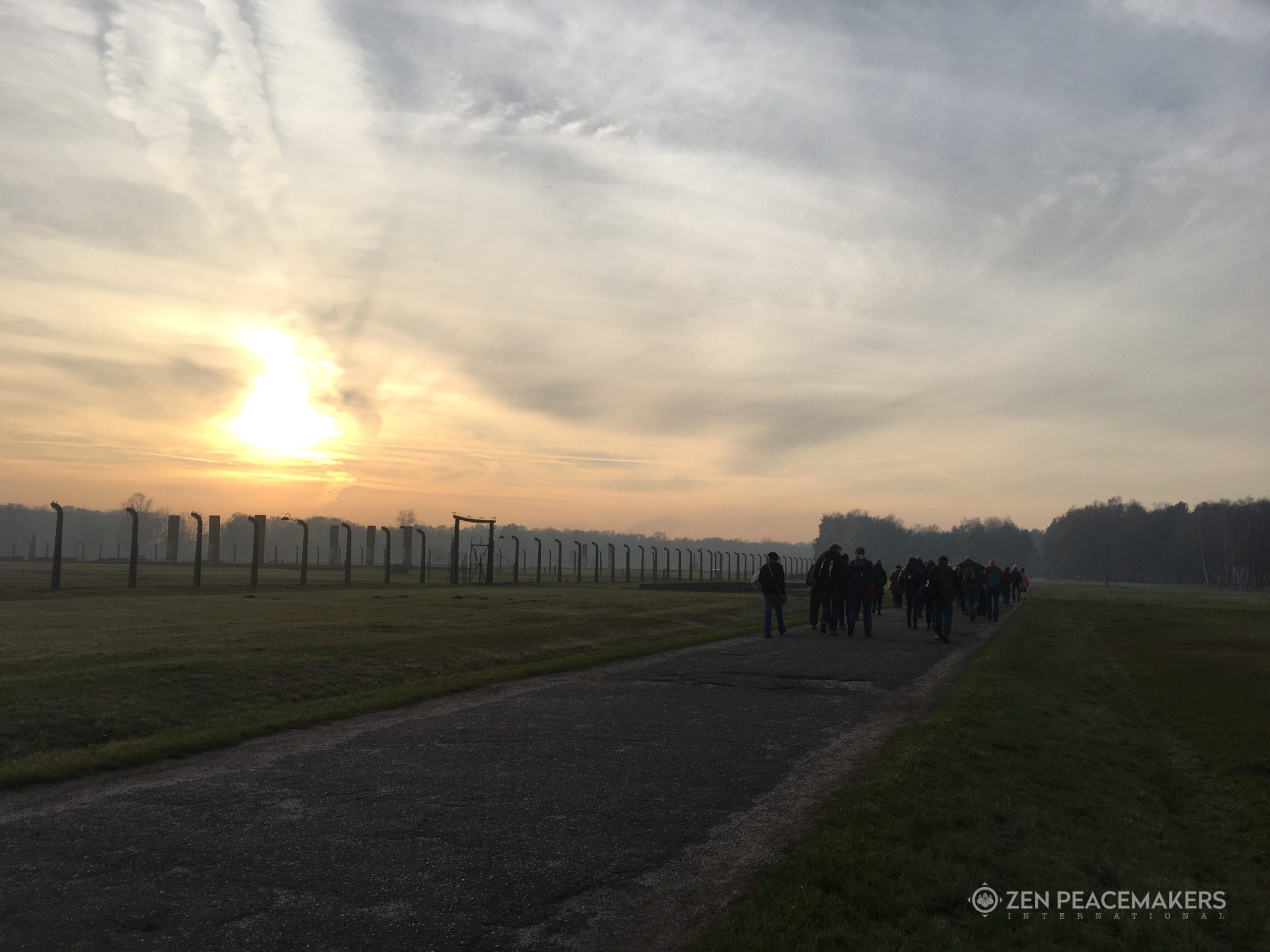
By Bernie Glassman
“When we realize that we are all bright pearls in Indra’s Net, we see that within each one of us the whole body of the universe is contained. Since we are all already connected in Indra’s Net, there are no limits to the possibilities of connecting with other people in our lives and our work.”
Indra was an ancient king of India who thought a great deal of himself. One day he went to the royal architect and said that he wanted to leave a monument of himself, something which all people would appreciate. The king’s architect created an immense net which extended throughout all space and time. And the king’s treasurer placed a bright, shining pearl at each node of the net so that every pearl was reflected in every other pearl. And each single pearl, each person, each event, contains the whole of Indra’s Net, including all of space and time.
When we realize that we are all bright pearls in Indra’s Net, we see that within each one of us the whole body of the universe is contained. Since we are all already connected in Indra’s Net, there are no limits to the possibilities of connecting with other people in our lives and our work.
Still, it’s natural for most of us to begin “networking” with the people closest to our own interests and needs. Accountants network with other accountants, poets with other poets, and social activists with other social activists. This kind of networking certainly has its uses. It’s especially effective, for example, when we need help in solving a very difficult problem. But it is not a very effective overall strategy because it leads to a narrowing instead of a widening of your network. It results in ever diminishing returns. The tax accountants end up talking only to other tax accountants; the free verse poets end up talking only to other free verse poets; and the social activists of one school end up talking only to social activists of the same school.
When we network according to the vision of Indra’s Net, on the other hand, we begin by casting the widest possible net. We do this by defining our mission in the broadest possible way.
The Mala practice of the Zen Peacemakers continues two legacies – the old Buddhist practice of alms-begging, and Bernie Glassman’s creative, maverick entrepreneurship

The Mala practice of the Zen Peacemakers continues two legacies – the old Buddhist practice of alms-begging, and Bernie Glassman’s creative, maverick entrepreneurship.
Whether you raise funds for your tuition on one of ZPI’s Bearing Witness programs, for your membership contribution or for your own projects, ZPI encourages everyone to reach out to close ones and include others in what otherwise may be a very personal journey or endeavor. You will raise awareness for the causes you believe in, and support the raising of global awareness.
What is Mala Practice?
2,500 years ago, it was the practice of the lay congregation to support monks through donations of food and clothing. Shakyamuni Buddha led his monks each morning in the practice of begging for their daily food. Each day’s offering was received with thanks regardless of its nature or size. In this way the Buddha encouraged simplicity, the generosity of both giving and receiving, and undiscriminating appreciation.
We continue this begging practice by raising support for our work by assembling a mala, or beads that are strung together and worn like a necklace. Each bead represents a person who supports that member’s vision and work, and the entire mala represents the Member’s community of support.
This is a practice of giving and receiving. By asking for support from family, friends, and associates, we acknowledge that as individuals, we are limited in what we can do. We depend on the generosity of others to increase our membership, train more peacemakers, and develop and support more programs. This is one more way in which we bear witness to the interdependence of life.
Your practice includes everything, including money.
Another important aspect of mala practice is the incorporation of the ministry of money in our program. When you assemble a mala, you include the management of money and fundraising in the work of peacemaking work and spiritual practice; the give-and-take of money is the compassionate, unobstructed flow of energy that nourishes and transforms our activities.
Mala practice also gives us the opportunity to share our work with our families, friends, and associates. Most of us lead professional work lives and have families. By raising money for our Socially Engaged Buddhist work, we publicize its activities, and most important, our own commitment. By wearing the beads we have assembled, we take our supporters with us in our peacemaking endeavors and on Bearing Witness retreats such as at Auschwitz, thus making family and friends an intimate part of this peacemaking journey.
Share your Gifts
With today’s social media and crowdfunding platforms, it is simple to set up ways for people to support you. Try to think creatively. What are your gifts? How can you continue your connection with your supporters before, during or after your event or reaching your mala goal? If you can draw or write poems, perhaps offer sketches or share your writing. Consider organizing a ‘salon’ event at your community hall or presentation at your office. You will return from your trip with many experiences that those who supported you will be wanting to hear.
The Five Buddha Families is a Buddhist teaching that suggests the view of existence as a mandala, a composite of five main energies or ‘families’ of Buddhas. Each family is unique, indispensable and complements the others. Each aspect of reality, every animal, person, thought/word/deed, conflict, action can be viewed as a composite of the five, each in different balances and levels of constraint or liberation, delusion or realization. When viewed holistically, realized and unrealized potential energies can be discerned and invoked through practice of chants, prayer or visualization or other creative means. The chart below lays out the basic characteristics of the five Buddha Families.
The Five Buddha Families is a fundamental teaching in Zen Peacemakers activities. Founder Zen Master Bernie Glassman developed Bearing Witness retreats as well as social enterprises such as Greyston, based on these teachings, ever reaching to a finer articulation of the needs of those he served.
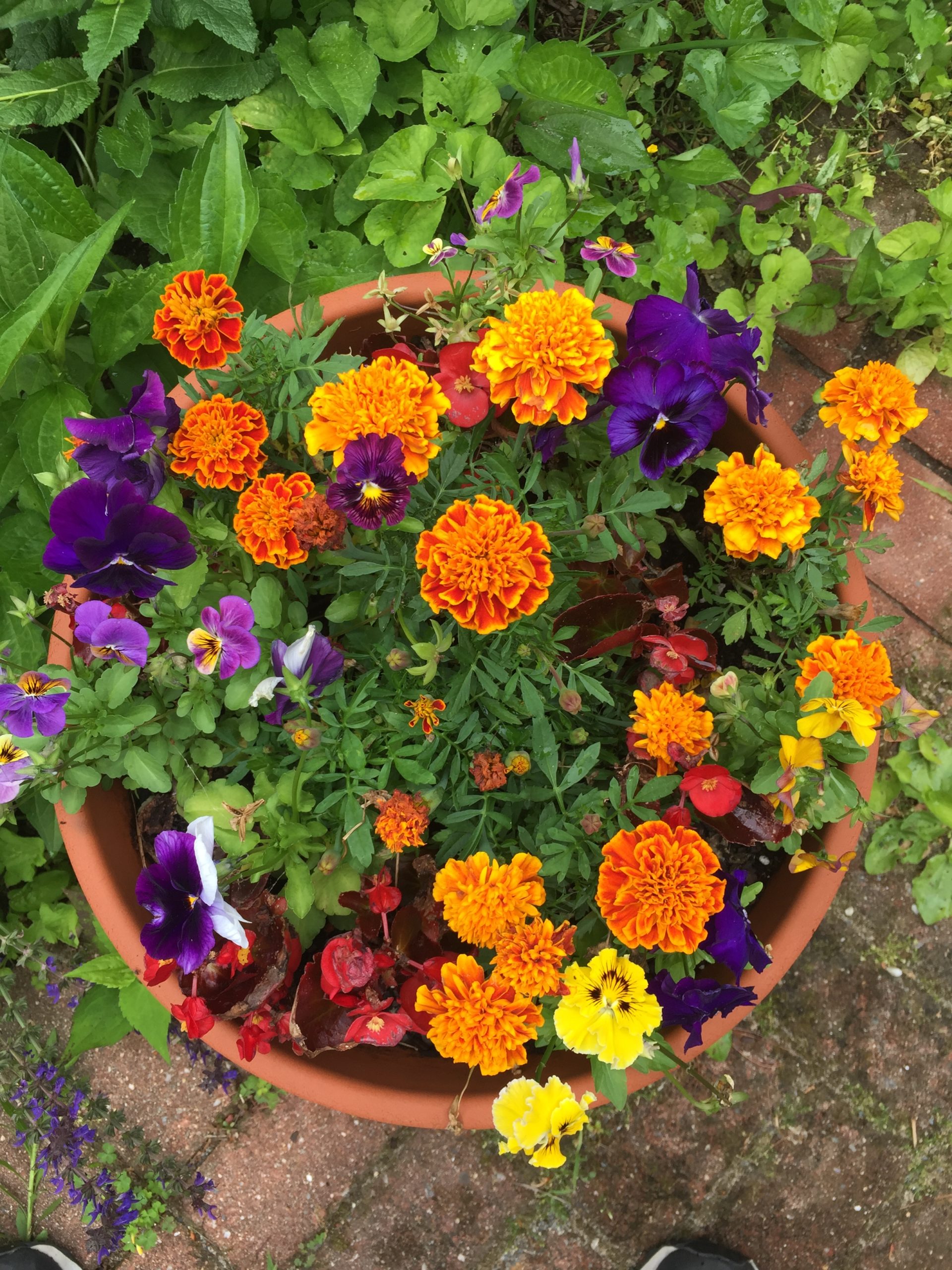
| ||||||||||||||||||||||||||||||||||||||||||||||||||||||||||||||||||||||||||||||||||||||||||||||||||||||||||||||||||||||||||||||||||||||||||||||||||||||||||||||||||||||||||||||
The foundation of the Gate of Sweet Nectar ceremony is based on Ananda’s deep connection with his mother, and his great suffering in relation to her trials in her afterlife. Ananda, according to lore, then went to the Buddha to see if there was anything he could do to help his mother. The Gate of Sweet Nectar was the Buddha’s gift to Ananda.
The ceremony is a profound plea to bring all the aspects of ourselves and of society that haven’t been served, that haven’t been taken care of to manifest right here and right now. It goes to the root of Buddhism itself, which is to save all sentient beings, understanding that we are all the Buddha and we all suffer. It is through this acknowledgment and through the ‘practice of the 3 tenets that all hungry spirits are liberated.

(Run and 3 bows)
(Officiant offers incense)
Ø Ø Ø ∆
Gate of Sweet Nectar
Ø (Sung 2x- Once by officiant and once in unison with all)
Calling out to hungry hearts
Everywhere through endless time
You who wander, you who thirst
I offer you this bodhi mind.
Calling out to hungry spirits
Everywhere through endless time
Calling out to hungry hearts
All the lost and left-behind
Gather round and share this meal
Your joy and your sorrow
I make them mine.
(Officiant offers incense)
Invitation for all our Aspects to be in attendance (Everyone in gassho)
Ø
Buddham Saranam Gacchami
Ø
Dhammam Saranam Gacchami
Ø
Sangham Saranam Gacchami
Ø
Being One with the Buddhas in the Ten Directions
Ø
Being One with the Dharma in the Ten Directions
Ø
Being One with the Sangha in the Ten Directions
Ø
Being One with all the Formless Forms throughout space and time
Ø
Being One with the great Manjusri Bodhisattva
Ø
Being One with the great compassionate Avalokitesvara Bodhisattva
Ø
Being One with our original teacher Shakyamuni Buddha
Ø
Being One with our lineage from Mahakasyapa Sonja
Ø
Being One with the Mahayana Saddharma Pundarika Sutra
Ø
Being One with Maha Prajna Paramita
Ø
Supplication for the Raising of the Bodhi Mind
Vow to feed the hungry spirits
° (officiant bows at altar) Attention! ° (halfway to bowing cushion) Attention!
° Raising the Bodhi Mind, the supreme meal is offered to all the hungry spirits throughout space and time,
filling the smallest particle to the largest space. All you hungry spirits in the ten directions, please gather here. Sharing your distress, I offer you this food, hoping it will resolve your thirsts and hungers.
Prayer of food sharing
Ø I pray that all who receive this offering will return its merits to all Buddhas \\ and to all creations throughout space and time: in this way they will be thoroughly satisfied.
Prayer for Raising the Bodhi Mind
° I further pray that in receiving this meal all your sufferings will be eliminated, and that you will be liberated, so that being joyously reborn you will play freely in the fields of the Pure Land. Raising the Bodhi Mind and practicing the Enlightened Way, you become the future Buddhas without any further regress. Those who realize the way first, please vow to liberate all others throughout all space and time.
Prayer for fulfilling these vows.
Ø I further beseech you to sustain me day and night and give me courage to fulfill my vows.
Prayer for transferring the merit of this practice.
° In offering this meal, I pray that you give its merits equally to all creations in the Dharma worlds. Please transfer the merits of this offering to the Dharma world of True Reality, to unsurpassable enlightenment, and to all the Buddha wisdoms.
Repeated prayer to attain the Enlightened Way.
Ø With all our love, with all our spirit, and with all our energy, \\ inviting misery and suffering no longer, we vow to accomplish the Way. \\ May all creations in the Dharma world swiftly ° accomplish the Buddha Way together.
Dharani for the Invitation of the Manifestation of all the Gods and Demons
Ø NOBO BO HO RI GYA RI TA RI ° TA
TA GYA TA YA
Ø Being one with the Unconditioned ° Tathagata.
Dharani of Hell Crushing and Hungry Spirit Throat Opening
Ø OM BO HO TEI RI GYA TA RI ° TA
TA GYA TA YA
Ø Being one with the Boundless ° Tathagata.
Dharani of Expansion Prayer upon the Food and Drink
Ø NO MAKU SA RA BA TA TA GYA TA BARO KI TEI OM°
SAN BA RA SAN BA RA UN
Ø Being one with all Tathagatas and Avalokitesvara Bodhisattva, °
please nourish and sustain us.
Dharani upon the Dharma Taste of the Sweet Nectar
Ø NO MAKU SO RO BA YA TA TA GYA TA YA TA
NYA TA OM
SO RO SO RO HA RA SO RO ° HA RA SO RO SO WA KA
Ø Being one with the Inconceivable Body Tathagata, let the nectar of Dharma ° spring forth.
Dharani of feeding all the Hungry Spirits (Gassho)
(Repeat 14 times:)
Ø(1st x) NO MAKU SAN MAN DA°
(14thx) BO TA NAN BAN
(Repeat 7 times:)
Ø(1st x)Being One with all Buddhas, °
(7th x) I turn the water wheel of compassion.
Dharanis for Inviting the Buddhas of the Five Families
(Sanskrit is read once, English twice. Everyone in Gassho)
Invitation for the Manifestation of the Buddhas in the Padma Family
Ø NA MU TA HO NYO RAI NO BO BA GYA BA TEI
HA RA BO TA A RA TAN NO YA TA TA GYA TA YA JO KEN TON GO FU KU CHI EN MAN°
Being one with all Buddhas in the Unifying spheres, integrating all families, wealth and wisdom are in abundance.
Invitation for the Manifestation of the Buddhas in the Ratna Family
ØNA MU MYO SHIKI SHIN NYO RAI NO BO BA GYA BA TEI
SO RO BA YA TA TA GYA TA YA HA SHU RO GYO EN MAN SO KO °
Being one with all Buddhas in the Livelihood Spheres,
extending generosity, perfection of both body and mind appears.
Invitation for the Manifestation of the Buddhas in the Buddha Family
ØNA MU KAN RO O NYO RAI NO BO BA GYA BA TEI
A MI RI TEI A RAN JA YA TA TA GYA TA YA KAN PO SHIN JIN RYO JU KE RA KU °
Being one with all Buddhas in the Formless Spheres,
bodies overflow with boundless Dharma and our life is fulfilled.
Invitation for the Manifestation of the Buddhas in the Vajra Family
ØNA MU KO HAKU SHIN NYO RAI NO BO BA GYA BA TEI
BI HO RA GYA TA RA YA TA TA GYA TA YA IN KO KO DAI ON JIKI JU BO °
Being one with all Buddhas in the Study Spheres, throats are opened and eating and drinking fully satisfy.
Invitation for the Manifestation of the Buddhas in the Karma Family
ØNA MU RI FU I NYO RAI NO BO BA GYA BA TEI
A BA EN GYA RA YA TA TA GYA TA YA KU SHITSU JO RI GA KI SHU °
Being one with all Buddhas in the Service Spheres, • all sufferings of the Hungry Spirits • are healed.
Dharani for Raising the Bodhi Mind
(Everyone in Gassho)
(Once) Officiant: OM BO JI SHI TA BO DA HA DA YA MI °
All: OM BO JI SHI TA BO DA HA DA YA MI
(Twice) Officiant: Now I have raised the Bodhi Mind. °
All: Now I have raised the Bodhi Mind
Dharani of Giving the Bodhisattva Samaya Precepts (Everyone in Gassho)
(Once) Officiant: OM SAN MA YA SA TO BAN °
All: OM SAN MA YA SA TO BAN
(Twice) Officiant: I am the Buddhas and they are me. °
All: I am the Buddhas and they are me.
Gatha for Transference of Merit
Ø By this practice I sincerely wish to extend all my love to my own being, friends, enemies, family and community, and to all creations for so much done on my behalf. •
May those who practice in this sphere continue to empower, to enrich, to enjoy. •
May those who have gone be released from suffering and nourish peacefulness. •
May all creations in the three worlds receive loving benefactions. •
May those suffering on the three paths come to atonement and be cleansed of all their ills. •
May they be liberated from samsara • and arise in the Pure Land • together.°
Dedication
(Chanter) Buddha nature pervades the whole universe, existing right here right now.
In reciting the Gate of Sweet Nectar we dedicate its merits to:
• The all-‐pervading and everlasting Three Treasures,
All Buddhas and Bodhisattvas in the realm of prajna wisdom, All protectors of the Dharma
And all beings in the Dharma worlds. •
Let us forever remember the causes of suffering.
Let us forever believe in the end to suffering.
May we always have the courage to bear witness,
To see ourselves as Other and Other as ourselves.
May penetrating light dispel the darkness of ignorance.
Let all karma be resolved and the mind flower bloom in eternal spring.
May we all ascend to enlightenment, great peace and love
And let us vow to feed all the hungry spirits together.
Closing Verse
(Everyone in Gassho)
Ø (1st, 3rd and 4thx)
This is our life,
The length of our days.
Day and night
We meditate upon it.


